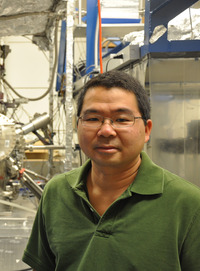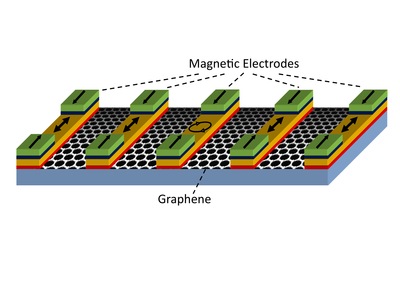SCIENCE
Physicists to Develop New Way of Electronic Computing
UC Riverside’s Roland Kawakami leads a four-year $1.85 multicampus research project aimed at speeding up applications that process large amounts of data
The University of California, Riverside has received a $1.85 million grant to develop a new way of computing that is beyond the scope of conventional silicon electronics.
The goal of the project is to speed up applications that process large amounts of data such as internet searching, data compression, and image recognition .
.
The money is awarded to UC Riverside under the nationwide “Nanoelectronics for 2020 and Beyond” competition sponsored by the National Science Foundation and the Nanoelectronics Research Initiative.
“Conventional silicon electronics will soon face its ultimate limits,” saidRoland Kawakami, a professor of physics and astronomy and the four-year grant’s principal investigator. “Our approach is to utilize the spin degree of freedom to store and process information, which will allow the functions of logic and memory to be fully integrated into a single chip.”
Spin is a fundamental characteristic property of electrons which causes them to behave as tiny magnets with a “north” and “south” pole. Electrons can occupy different spin states corresponding to different orientations for the magnetic poles. For spin-based computing, data is held in the spin state of the electron.
Kawakami explained that unlike more traditional approaches to improve electronics by building a better transistor, the current project has a far more transformative approach.
“We are looking at a completely new architecture or framework for computing,” he said. “This involves developing a new type of ‘building-block’ device known as a magnetologic gate that will serve as the engine for this technology – similar to the role of the transistor in conventional electronics. In addition, we will develop and design the circuits needed to utilize this device for specific functions, such as searching, sorting, and forecasting.”
A magnetologic gate consists of graphene contacted by several magnetic electrodes. Data is stored in the magnetic state of the electrodes, similar to the way data is stored in a magnetic hard drive. For the logic operations, electrons move through the graphene and use its spin state to compare the information held in the individual magnetic electrodes.
The research project, which began Sept. 15, is a multicampus effort being led by UC Riverside. The research group of Jing Shi, a UCR professor of physics and astronomy, will work closely with Kawakami’s research group on the project. They will be joined by Ilya Krivorotov at UC Irvine; Lu Sham at UC San Diego; Igor Zutic at SUNY Buffalo, NY; and Hanan Dery and Hui Wu at the University of Rochester, NY.
“Our team consists of experts in spintronics, magnetoresistive memory, theoretical physics, circuit design, and CMOS integration, a technology for constructing integrated circuits,” said Kawakami, a member of UCR’s Center for Nanoscale Science and Engineering.
The project is based on two major breakthroughs in nanoelectronics: The concept of spin-based computing using a magnetologic gate designed by Sham’s group at UC San Diego in 2007; and the demonstration of tunneling spin injection and spin transport in graphene by Kawakami's group in 2010.
“Bringing these two results together, we find that graphene is the most promising material for developing magnetologic gates in terms of high speed, low energy usage, and operation at room temperature,” Kawakami said.
Most of the experimental work will be done at UCR and UC Irvine. The circuit design and theory will be done at UC San Diego, the University of Rochester, and SUNY Buffalo.  Enlarge {jvotesystem poll==1}
Enlarge {jvotesystem poll==1}
The University of California, Riverside has received a $1.85 million grant to develop a new way of computing that is beyond the scope of conventional silicon electronics.
The goal of the project is to speed up applications that process large amounts of data such as internet searching, data compression, and image recognition
 .
.The money is awarded to UC Riverside under the nationwide “Nanoelectronics for 2020 and Beyond” competition sponsored by the National Science Foundation and the Nanoelectronics Research Initiative.
“Conventional silicon electronics will soon face its ultimate limits,” saidRoland Kawakami, a professor of physics and astronomy and the four-year grant’s principal investigator. “Our approach is to utilize the spin degree of freedom to store and process information, which will allow the functions of logic and memory to be fully integrated into a single chip.”
Spin is a fundamental characteristic property of electrons which causes them to behave as tiny magnets with a “north” and “south” pole. Electrons can occupy different spin states corresponding to different orientations for the magnetic poles. For spin-based computing, data is held in the spin state of the electron.
Kawakami explained that unlike more traditional approaches to improve electronics by building a better transistor, the current project has a far more transformative approach.
“We are looking at a completely new architecture or framework for computing,” he said. “This involves developing a new type of ‘building-block’ device known as a magnetologic gate that will serve as the engine for this technology – similar to the role of the transistor in conventional electronics. In addition, we will develop and design the circuits needed to utilize this device for specific functions, such as searching, sorting, and forecasting.”
A magnetologic gate consists of graphene contacted by several magnetic electrodes. Data is stored in the magnetic state of the electrodes, similar to the way data is stored in a magnetic hard drive. For the logic operations, electrons move through the graphene and use its spin state to compare the information held in the individual magnetic electrodes.
The research project, which began Sept. 15, is a multicampus effort being led by UC Riverside. The research group of Jing Shi, a UCR professor of physics and astronomy, will work closely with Kawakami’s research group on the project. They will be joined by Ilya Krivorotov at UC Irvine; Lu Sham at UC San Diego; Igor Zutic at SUNY Buffalo, NY; and Hanan Dery and Hui Wu at the University of Rochester, NY.
“Our team consists of experts in spintronics, magnetoresistive memory, theoretical physics, circuit design, and CMOS integration, a technology for constructing integrated circuits,” said Kawakami, a member of UCR’s Center for Nanoscale Science and Engineering.
The project is based on two major breakthroughs in nanoelectronics: The concept of spin-based computing using a magnetologic gate designed by Sham’s group at UC San Diego in 2007; and the demonstration of tunneling spin injection and spin transport in graphene by Kawakami's group in 2010.
“Bringing these two results together, we find that graphene is the most promising material for developing magnetologic gates in terms of high speed, low energy usage, and operation at room temperature,” Kawakami said.
Most of the experimental work will be done at UCR and UC Irvine. The circuit design and theory will be done at UC San Diego, the University of Rochester, and SUNY Buffalo.
 Enlarge
Enlarge The image shows a magnetologic gate, which consists of graphene contacted by several magnetic electrodes. Data is stored in the magnetic state of the electrodes, similar to the way data is stored in a magnetic hard drive. For the logic operations, electrons move through the graphene and use its spin state to compare the information held in the individual magnetic electrodes. Image credit: Kawakami lab, UC Riverside.
RELATED LINKS
- More about Roland Kawakami
- Department of Physics and Astronomy
- Center for Nanoscale Science and Engineering
